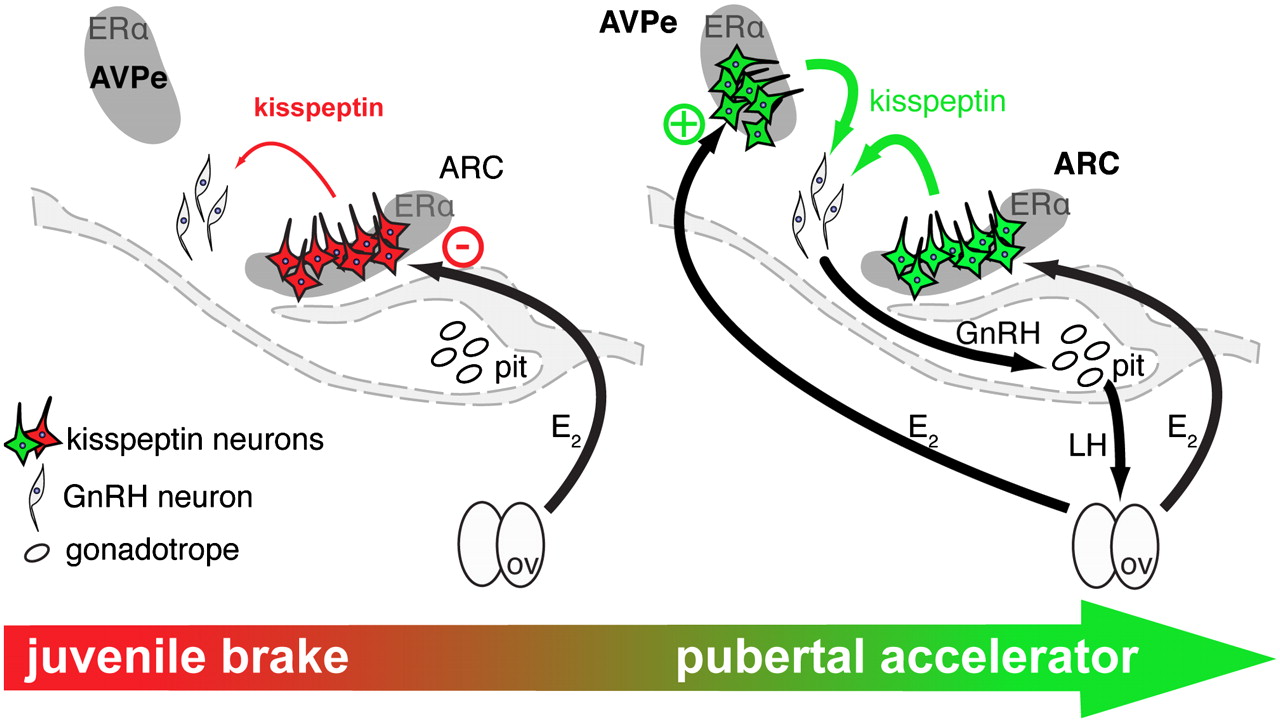Biology of Reproduction, lecture on Menstual Cycles
XVIII. Menstrual Cycle
A. Reproductive cycles have varied lengths
1. Human Menstrual Cycles are about one month long
a. Menses - from month
b. circalunar
| day 1 start of menstruation to 5 |
5 to 14 |
14 |
14 to 28 |
| Menstrual Phase |
Follicular Phase |
ovulation |
Luteal Phase |
| 1-6 days |
variable |
|
begins 14 days before the
start of the next cycle |
| Destructive Phase |
Estrogenic Phase |
|
Progestogenic Phase |
| Menses |
Proliferative Phase |
|
Secretory Phase |
endometrial sloughing
menstrual bleeding |
growth of ovary
and large follicle |
|
corpus luteum |
c. for a 35 day cycle
| Menstrual |
Follicular |
Luteal |
| 5 days |
16 |
14 |
| small variation |
highly variable |
least variable |
d. Average cycle length = 30 days
i. menstrual + follicular phase average = 16.9
ii. luteal phase average = 12.9
B. Menstrual Phase
1. Stratum Functionalis of Endometrium sloughs off
a. Stratum basalis remains
2. 25 to 75 ml of blood is lost (1 - 2.5 ounces; up to 250 ml)
3. Ovaries
a. Day 1 - all follicles < 5mm diameter
b. Day 3 - several follicles ~3 - 10mm
C. Follicular Phase
1. Uterine growth
a. uterine glands
b. no. of blood vessels
2. Ovaries
a. day 10 - 12: several follicles (e.g. 10) 14 - 21mm
b. day 13: only one large follicle 20 - 25mm
i. atresia for the rest
D. Luteal Phase
1. Stratum Functionalis
a. Spongy: Edematous, many blood vessels,
uterine glands secretory (uteroglobin)
i. Ready to accept Embryo
2. Corpus Luteum
a. P
i. E/P < 1
ii. negative feedback ® ¯ GnRH ® ¯ FSH
iii. \ Follicles don't grow
b. Luteolysis
i. death of corpus luteum begins
after ~ 7 days of luteal life
ii. ¯ P and ¯ E
iii. loss of support for endometrium
c. What kills the corpus luteum? (3 hypotheses)
i. ¯ LH ® regression
(1) ¯ LH-R coincides with luteolysis
(2) but LH administration during luteolysis
does not extend luteal life
(3) hCG saves the corpus luteum
during early pregnancy
ii. Oxytocin (Oxy)
(1) produced by corpus luteum
(2) causes production of PGF2a
iii. Prostaglandin F2a
(1) restricts blood flow
(2) produced by corpus luteum
(3) causes down-regulation of LH-R
(4) inhibits steroidogenesis
(a) ¯ P ® DHP
(5) immune cells
(6) oxygen radicals
(a) rigid membranes
(7) apoptosis (apo = away; ptosis = to fall)
= programmed cell death
- via NO (nitric oxide)?
E. Body Temperature
1. 0.3 - 0.5oC (0.5-1.0oF) rise in To
approximately at the time of ovulation:
caused by rise in P
a. luteinization begins just before the LH surge
F. Mucus
1. Cervical mucus is thick and less penetrable to sperm
until 3 - 5 days before,
and lasting 1 - 3 days after ovulation
2. during ovulation cervical mucus becomes more watery
3. E2 dominant: watery, threadlike mucus
4. P: Thick and Sticky
a. Fern test
G. Amenorrhea
1. 1o
a. no menarche by the end of the 16th year
2. Oligomenorrhea
a. erratic menstrual cycles
3. 2o amenorrhea
a. no menstrual cycle for 6 months
i. after having menstruated previously
b. natural during:
i. pregnancy
ii. lactation
iii. menopause
c. anorexia leads to amenorrhea
i. reduced fat ® reduced E2
(1) true for some athletes also
ii. infertility
iii. osteoporosis in the absence of exercise
H. Dysmenorrhea
1. Painful or difficult menstruation
2. 30-50% of women
3. main symptom: painful cramps
a. PGF2a ® more intense cramps
b. PGF2a causes endometrial sloughing
by constricting blood vessels
c. PGF2a has a very strong contractile effect
on smooth muscle, including myometrium
i. as effective as Oxy to induce labor
d. cramping results when muscle contractions
take place in areas with low blood supply
i. incomplete peristalsis
ii. PGF2a causes blood vessels constriction
e. Anti-prostaglandins block cramping
i. Aspirin - works this way for headaches too
ii. Acetaminophen
iii. Indomenthacin
iv. Ibuprofen
f. Combination Pill supposedly reduces cramps by a rapid
decrease in E/P ratio resulting in less PGF2a
I. Premenstrual Syndrome
1. syndrome = group of related symptoms
2. 70-90% of adult women experience one or more symptoms
a. severe in 5%
3. Physical components
a. migraine headache
b. fatigue
c. edema
i. bloating, breast tenderness, asthma,
tingling/swelling in hands and feet, body weight
ii. urination
d. food craving
e. heart palpitation
f. nausia
g. dizziness
h. acne
i. cramps, muscle spasms, backache
4. Emotional Components = Premenstrual Tension
a. anxiety
b. depression
c. irritability
d. restlessness
e. lethargy
f. tension
5. Causes - Treatment
a. Hormonal Hypothesis
i. Luteolysis ® ¯ hormones (P + E2)
(1) ¯ P + E2 ® ¯ tryptophan ® ¯ serotonin (5-HT)
(a) E2 ® 5-HT
(2) stress accentuates ¯ 5-HT effect
ii. treatments
(1) exogenous P - not effective for severe PMS
(2) fluoxetine (prozac) and alprazolam (xanax) effective
for severe PMS
b. Water Retention Hypothesis
i. Aldosterone and P increase during luteal phase
(1) result in edema
ii. swelling causes symptoms
iii. treatment = diuretic
c. Dietary Hypothesis
i. vitamin B6 depletion in the
nervous system during the luteal phase
ii. treatment = vitamin B6
